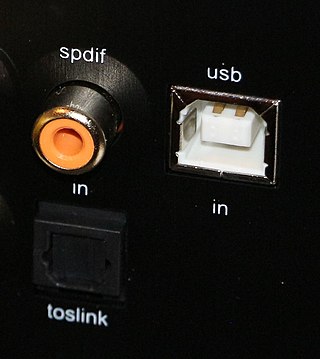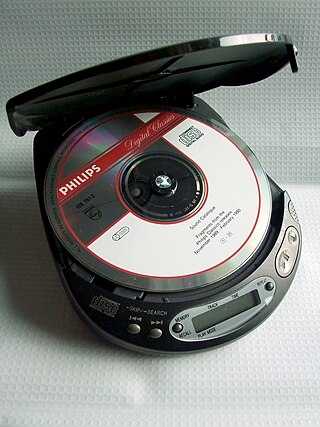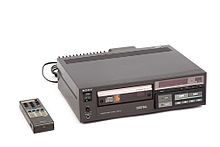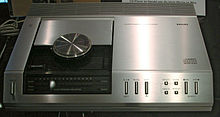
The compact disc (CD) is a digital optical disc data storage format that was co-developed by Philips and Sony to store and play digital audio recordings. It uses the Compact Disc Digital Audio format which typically provides 74 minutes of audio on a disc. In later years, the compact disc was adapted for non-audio computer data storage purposes as CD-ROM and its derivatives. First released in Japan in October 1982, the CD was the second optical disc technology to be invented, after the much larger LaserDisc (LD). By 2007, 200 billion CDs had been sold worldwide.

Compact Disc Digital Audio, also known as Digital Audio Compact Disc or simply as Audio CD, is the standard format for audio compact discs. The standard is defined in the Red Book technical specifications, which is why the format is also dubbed "Redbook audio" in some contexts. CDDA utilizes pulse-code modulation (PCM) and uses a 44,100 Hz sampling frequency and 16-bit resolution, and was originally specified to store up to 74 minutes of stereo audio per disc.

MiniDisc (MD) is an erasable magneto-optical disc-based data storage format offering a capacity of 60, 74, and later, 80 minutes of digitized audio.

Super Audio CD (SACD) is an optical disc format for audio storage introduced in 1999. It was developed jointly by Sony and Philips Electronics and intended to be the successor to the compact disc (CD) format.

S/PDIF is a type of digital audio interface used in consumer audio equipment to output audio over relatively short distances. The signal is transmitted over either a coaxial cable using RCA or BNC connectors, or a fibre-optic cable using TOSLINK connectors. S/PDIF interconnects components in home theaters and other digital high-fidelity systems.

A CD player is an electronic device that plays audio compact discs, which are a digital optical disc data storage format. CD players were first sold to consumers in 1982. CDs typically contain recordings of audio material such as music or audiobooks. CD players may be part of home stereo systems, car audio systems, personal computers, or portable CD players such as CD boomboxes. Most CD players produce an output signal via a headphone jack or RCA jacks. To use a CD player in a home stereo system, the user connects an RCA cable from the RCA jacks to a hi-fi and loudspeakers for listening to music. To listen to music using a CD player with a headphone output jack, the user plugs headphones or earphones into the headphone jack.

In computing, an optical disc drive (ODD) is a disc drive that uses laser light or electromagnetic waves within or near the visible light spectrum as part of the process of reading or writing data to or from optical discs. Some drives can only read from certain discs, while other drives can both read and record. Those drives are called burners or writers since they physically burn the data onto on the discs. Compact discs, DVDs, and Blu-ray discs are common types of optical media which can be read and recorded by such drives.

Direct Stream Digital (DSD) is a trademark used by Sony and Philips for their system for digitally encoding audio signals for the Super Audio CD (SACD).

A magneto-optical drive is a kind of optical disc drive capable of writing and rewriting data upon a magneto-optical disc. 130 mm (5.25 in) and 90 mm (3.5 in) discs are the most common sizes.

In digital recording, an audio or video signal is converted into a stream of discrete numbers representing the changes over time in air pressure for audio, or chroma and luminance values for video. This number stream is saved to a storage device. To play back a digital recording, the numbers are retrieved and converted back into their original analog audio or video forms so that they can be heard or seen.
Eight-to-fourteen modulation (EFM) is a data encoding technique – formally, a line code – used by compact discs (CD), laserdiscs (LD) and pre-Hi-MD MiniDiscs. EFMPlus is a related code, used in DVDs and Super Audio CDs (SACDs).

Kornelis Antonie "Kees" Schouhamer Immink is a Dutch engineer, inventor, and entrepreneur, who pioneered and advanced the era of digital audio, video, and data recording, including popular digital media such as compact disc (CD), DVD and Blu-ray disc. He has been a prolific and influential engineer, who holds more than 1100 U.S. and international patents. A large portion of the commonly used audio and video playback and recording devices use technologies based on his work. His contributions to coding systems assisted the digital video and audio revolution, by enabling reliable data storage at information densities previously unattainable.

Discman was a brand name used by Sony for their portable CD players. The first Discman, the Sony D-50 or D-5, was launched in 1984. The Sony brand name for Discman changed to CD Walkman, initially for Japanese lineups launched between October 1997 and March 1998, and then entirely in 2000. Discman and CD Walkman players were discontinued at the beginning of the 2010s when they lost popularity with the general public.
In the compact disc system, cross-interleaved Reed–Solomon code (CIRC) provides error detection and error correction. CIRC adds to every three data bytes one redundant parity byte.
Versuni is a privately-owned Dutch company, headquartered in Amsterdam, which produces consumer electronics and small appliances. Formerly a subsidiary of Dutch electronics conglomerate Philips, it was sold to Chinese private equity firm Hillhouse Investment in 2021. Versuni sells their products under the Philips brand name, as well as under the brands Preethi, Gaggia and Saeco, Senseo and L'Or.

In digital audio using pulse-code modulation (PCM), bit depth is the number of bits of information in each sample, and it directly corresponds to the resolution of each sample. Examples of bit depth include Compact Disc Digital Audio, which uses 16 bits per sample, and DVD-Audio and Blu-ray Disc, which can support up to 24 bits per sample.

A CD-ROM is a type of read-only memory consisting of a pre-pressed optical compact disc that contains data computers can read, but not write or erase. Some CDs, called enhanced CDs, hold both computer data and audio with the latter capable of being played on a CD player, while data is only usable on a computer.
The history of optical recording can be divided into a few number of distinct major contributions. The pioneers of optical recording worked mostly independently, and their solutions to the many technical challenges have very distinctive features, such as
Toshitada Doi is a Japanese electrical engineer, who played a significant role in the digital audio revolution. He received a degree in electrical engineering from the Tokyo Institute of Technology in 1964, and a PhD from Tohoku University in 1972.

The Philips Natuurkundig Laboratorium or NatLab was the Dutch section of the Philips research department, which did research for the product divisions of that company.

















